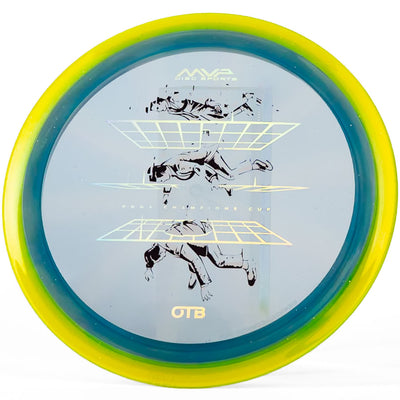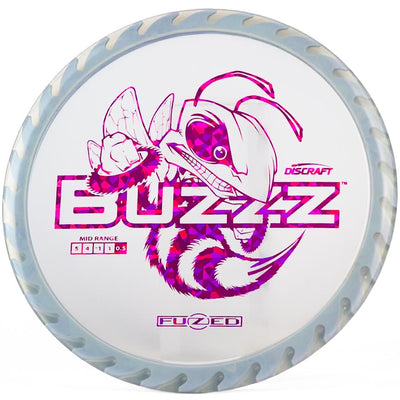Prodigy M4 Vs Discraft Buzzz: Midrange Showdown

If you are in the market for a straight flying midrange disc, chances are you have come across the Prodigy M4 and Discraft Buzzz. Both of these discs are great for beginner disc golfers, but which one is better?
We did a hands on review and compared the Prodigy M4 vs Buzzz to help you decide which one is right for you.
In a nutshell:
- The Discraft Buzzz is one of the most popular discs ever made and has slightly less glide than the M4.
-
The Prodigy M4 has a slightly deeper rim, more glide and is slightly less stable than the Buzzz.
Prodigy M4 Vs Buzzz
Welcome to Disc Golf. So, you're staring at a wall of discs. Where do you start? You've got your putters and some distance drivers to try out. What's the best midrange for you?
You want something that will fly straight, have some slight smooth turn, and a soft, straight finish. The Discraft Buzzz and the Prodigy M4 are really sticking out to you.
Both are mid-ranges, and fly extremely straight, but there are some differences between them physically.
The dimensions of midrange discs can vary by size, weight, rim size, and depth. All of these things are important to take into consideration when picking out a disc; each have their own downsides and benefits.
Prodigy M4

Coming in at 8.5 inches (21.7cm), the weight of the M4 tops out at 180 grams, just like most other midranges
Max weight discs (177+ grams) are better suited for players with quicker arm speed, whereas lighter weight discs are generally better suited for beginners.
The width of the rim of an M4 is approximately 1.4cm, and the height of this mold is 2.0cm. The M4 is known for having a slightly higher profile (more dome) than other midranges, which produces more glide than flat-top discs.

The Prodigy M4 has a flight rating of 5 | 5 | -1 | 1
Discraft Buzzz

The Discraft Buzzz is also a stable midrange disc introduced by Discraft in 2003.
The Buzzz quickly became popular and is still one of the most popular disc golf discs used today. The Buzzz maxes out at 180 grams, most of them coming in between 170-177 grams scaled.
The Buzzz is a tad more shallow than the M4, measuring in at 1.9cm. The width of the rim for your average Buzzz is going to be 1.2cm, so slightly more narrow that that of an M4.
The speed of this mold is also 5, right in that sweet spot for a midrange disc. The glide is a little bit lower than with the M4, coming in at 4 rather than a 5.
This really just means that the Buzzz does not want to stay in the air for as long, or as far, as an M4. This mainly just goes to say that when a Buzzz and M4 are thrown flat, your Buzzz may need a little more air, or height, than the M4 to get the same distance.
Buzzz vs M4: Differences
The M4 is a tad 'taller' in profile than the Buzzz. They are both used for straight shots with minimal fade at the end.
Take a look at these flight charts from inbounddiscgolf.com:

If you look closely, you can see that the Prodigy M4 is slightly more understable, or 'flippy' as some call it, than the Buzzz. This means that if both are thrown on a flat release, the Buzzz has more of a straight line of flight, where the M4 will make more of an 'S' curve.
This also indicates that if you are looking for a good disc that can withstand a little more torque/power or a disc that may hold up better when tested with strong winds, the Buzzz may be the better option for you.
You would need to throw your M4 with slight hyzer angle to get the same flight path that you would get from a Buzzz when thrown flat.
You also need to think about exactly how you are going to throw these midranges. If forehand (or sidearm) is your answer, something important to keep in mind is that your new midrange will need to be able to handle a little more of a slight anhyzer, and more force behind the throw.
A lot of players who tend to throw forehand seem to opt more for the overstable option, to limit the margin of error.
M4 Vs Buzzz: Similarities

Where these two discs are similar, are the first and last two digits of their flight numbers. The last two indicators in the flight numbers are for turn and fade. After a few throws, you will see why they are so similar.
The numbers for turn on both of these straight flying midranges is -1. This means that the amount of turn or draw, is minimal when compared to more of an understable mid.
In regards to fade, or the amount of 'dump' a disc will have towards the end of its flight, these two discs are very similar as well. The number both of them show is this category is 1.

So what we gather from this number is that both of these molds will have minimal fade, compared to a more overstable disc, when losing speed at the very end of its flight.
If you are still confused about disc stability you can read more about the differences between understable and overstable discs here.
Available Plastics
Alright, so we've got the basics down. You've decided between the two molds which one you'd like to be your next favorite disc. Before you get out on the course, check out this list showing the different popular plastics these molds come in. (In order from highest to lowest grade of plastic):

Discraft Buzzz:
- Titanium (Ti) - Highest quality, beats in the slowest, decent amount of grip.
- Extra Special Plastic (ESP) : Slightly more grip than Ti, will beat in quicker.
- Z Buzzz: The grip is not great, but extremely durable. (Also comes in glow-in-the-dark)
- Z Flx: Same as Z Buzzzes, with slightly more grip.
- Pro-D: Discrafts base line plastic. Going to be the grippiest, while offering the least amount of durability.
Prodigy M4:
- 750G: The highest grade that Prodigy Disc offers.
- 750: Similar in feel to 750G with less durability and firmness.
- 500: The perfect balance between flex and firm, with a pearly look. You can shop M4 500 at our store.
- 400: Extremely durable and outstanding grip. (450G is similar, with a shot of adrenaline.)
- 350: Very grippy, with less durability than other plastics. (350G also an option, just a step up in grade)
- 300: The base plastic, most grippy of all, will beat in the fastest.
There You Have It
Now that we've looked at the nitty-gritty, you can decide which of these molds will be the most useful tool in your arsenal. The M4 is a tiny bit more understable than the Buzzz, but it will all come down to feel in hand. What do YOU like the most?
You can check out both of these discs at our online disc golf disc shop.













